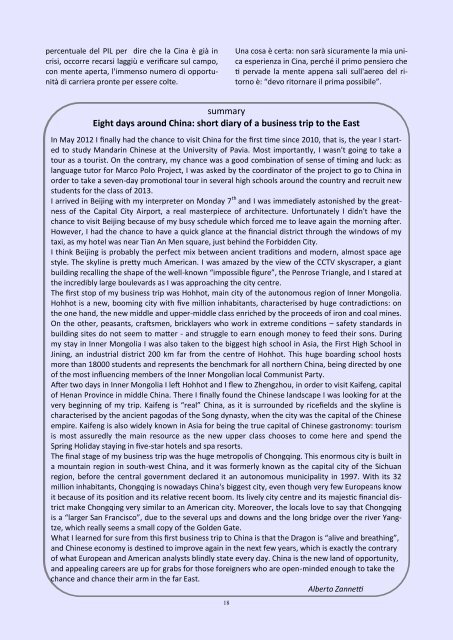n° 1 giugno 2012 - Ifuw Italia – Fildis sez. di Pavia
n° 1 giugno 2012 - Ifuw Italia – Fildis sez. di Pavia
n° 1 giugno 2012 - Ifuw Italia – Fildis sez. di Pavia
Create successful ePaper yourself
Turn your PDF publications into a flip-book with our unique Google optimized e-Paper software.
percentuale del PIL per <strong>di</strong>re che la Cina è già in<br />
crisi, occorre recarsi laggiù e verificare sul campo,<br />
con mente aperta, l'immenso numero <strong>di</strong> opportunità<br />
<strong>di</strong> carriera pronte per essere colte.<br />
18<br />
Una cosa è certa: non sarà sicuramente la mia unica<br />
esperienza in Cina, perché il primo pensiero che<br />
ti pervade la mente appena sali sull'aereo del ritorno<br />
è: “devo ritornare il prima possibile”.<br />
summary<br />
Eight days around China: short <strong>di</strong>ary of a business trip to the East<br />
In May <strong>2012</strong> I finally had the chance to visit China for the first time since 2010, that is, the year I started<br />
to study Mandarin Chinese at the University of <strong>Pavia</strong>. Most importantly, I wasn't going to take a<br />
tour as a tourist. On the contrary, my chance was a good combination of sense of timing and luck: as<br />
language tutor for Marco Polo Project, I was asked by the coor<strong>di</strong>nator of the project to go to China in<br />
order to take a seven-day promotional tour in several high schools around the country and recruit new<br />
students for the class of 2013.<br />
I arrived in Beijing with my interpreter on Monday 7 th and I was imme<strong>di</strong>ately astonished by the greatness<br />
of the Capital City Airport, a real masterpiece of architecture. Unfortunately I <strong>di</strong>dn't have the<br />
chance to visit Beijing because of my busy schedule which forced me to leave again the morning after.<br />
However, I had the chance to have a quick glance at the financial <strong>di</strong>strict through the windows of my<br />
taxi, as my hotel was near Tian An Men square, just behind the Forbidden City.<br />
I think Beijing is probably the perfect mix between ancient tra<strong>di</strong>tions and modern, almost space age<br />
style. The skyline is pretty much American. I was amazed by the view of the CCTV skyscraper, a giant<br />
buil<strong>di</strong>ng recalling the shape of the well-known “impossible figure”, the Penrose Triangle, and I stared at<br />
the incre<strong>di</strong>bly large boulevards as I was approaching the city centre.<br />
The first stop of my business trip was Hohhot, main city of the autonomous region of Inner Mongolia.<br />
Hohhot is a new, booming city with five million inhabitants, characterised by huge contra<strong>di</strong>ctions: on<br />
the one hand, the new middle and upper-middle class enriched by the proceeds of iron and coal mines.<br />
On the other, peasants, craftsmen, bricklayers who work in extreme con<strong>di</strong>tions <strong>–</strong> safety standards in<br />
buil<strong>di</strong>ng sites do not seem to matter - and struggle to earn enough money to feed their sons. During<br />
my stay in Inner Mongolia I was also taken to the biggest high school in Asia, the First High School in<br />
Jining, an industrial <strong>di</strong>strict 200 km far from the centre of Hohhot. This huge boar<strong>di</strong>ng school hosts<br />
more than 18000 students and represents the benchmark for all northern China, being <strong>di</strong>rected by one<br />
of the most influencing members of the Inner Mongolian local Communist Party.<br />
After two days in Inner Mongolia I left Hohhot and I flew to Zhengzhou, in order to visit Kaifeng, capital<br />
of Henan Province in middle China. There I finally found the Chinese landscape I was looking for at the<br />
very beginning of my trip. Kaifeng is “real” China, as it is surrounded by ricefields and the skyline is<br />
characterised by the ancient pagodas of the Song dynasty, when the city was the capital of the Chinese<br />
empire. Kaifeng is also widely known in Asia for being the true capital of Chinese gastronomy: tourism<br />
is most assuredly the main resource as the new upper class chooses to come here and spend the<br />
Spring Holiday staying in five-star hotels and spa resorts.<br />
The final stage of my business trip was the huge metropolis of Chongqing. This enormous city is built in<br />
a mountain region in south-west China, and it was formerly known as the capital city of the Sichuan<br />
region, before the central government declared it an autonomous municipality in 1997. With its 32<br />
million inhabitants, Chongqing is nowadays China's biggest city, even though very few Europeans know<br />
it because of its position and its relative recent boom. Its lively city centre and its majestic financial <strong>di</strong>strict<br />
make Chongqing very similar to an American city. Moreover, the locals love to say that Chongqing<br />
is a “larger San Francisco”, due to the several ups and downs and the long bridge over the river Yangtze,<br />
which really seems a small copy of the Golden Gate.<br />
What I learned for sure from this first business trip to China is that the Dragon is “alive and breathing”,<br />
and Chinese economy is destined to improve again in the next few years, which is exactly the contrary<br />
of what European and American analysts blindly state every day. China is the new land of opportunity,<br />
and appealing careers are up for grabs for those foreigners who are open-minded enough to take the<br />
chance and chance their arm in the far East.<br />
Alberto Zannetti



